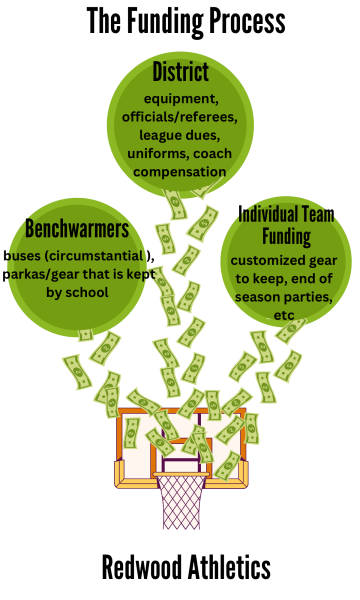Since they were created, sports have been a major source of entertainment, accumulating worldwide audiences that become captivated by determination, pride, and teamwork. However, male sports teams have generally received preferential treatment over female sports teams. Whether they are getting more media attention, higher wages or larger budgets, it hasn’t been equal. Within the past couple of decades, this issue has materialized as athletes fight for more equality.
Athletes like Alex Morgan have spoken out against discrepancies in pay between male and female athletes. Morgan, a top-performing women’s soccer player, published an article in the Cosmopolitan about her complaint to the U.S. Equal Employment Opportunity Commission. In the article, Morgan explains the motivation of her fight towards equality.
“We have dedicated our lives to this sport and our country…We think it’s time for U.S. soccer to truly address the inequality and do what is right,” said Morgan.
The U.S. Soccer Federation recently settled to equalize pay between their male and female players. While this does show progress, there is still a long way to go. Aside from everyday wages, there are inequalities present in larger events that gain considerable amounts of media attention. For instance, in 2019 the total prize money of the FIFA Women’s World Cup was $30 million, compared to the $400 million total prize money of the FIFA Men’s World Cup in 2018 — a $370 million difference.
Beyond the pay gap, issues with overall funding for sports teams have surfaced on a more local stage: the collegiate level. The National Collegiate Athletic Association (NCAA), reported that in 2020, men’s programs received over double the allocated resources as women’s programs at the Division One level. However, they also found a positive trend in the percentage of participation opportunities in collegiate sports for females. In 1992, 26.4 percent of participation opportunities were for women compared to 47.1 percent in 2020. That means after 28 years, there were 20.7 percent more opportunities for women. Change is slow-moving but it is underway.
Although a shift in social equality is important, it is only achievable if civil rights laws like Title IX are executed to their full capacity. Title IX is a federal civil rights law put in place to prevent sex-based discrimination in any educational space, including school athletics. In addition to mandating equal opportunities for males and females to participate in athletics, it ensures equal access to field space, coaching, equipment, and other resources associated with athletics. At Redwood and in the Tam District, this means that all athletes are entitled to equitable treatment and allocation of resources. Leslie Harlander, the president of the Tamalpais School District (TUHSD) Board, recalled an issue that was brought to the board a couple of years ago about a disparity in funding.
“We became concerned about the consistency [of funding] and what sorts of parameters there were,” Harlander said.
This concern soon translated into action as new guidelines were set with less gray area that could lead to an imbalance in funding. They were set in collaboration with school organizations like Benchwarmers, ensuring contributors to the funding process both understood and were in agreement with the new policies.
Jessica Peisch, the Redwood Athletic Director, provided insight on the updated management of resource distribution in our district and at Redwood. TUHSD has set parameters for what they provide each team with —uniforms, officials, coaches’ compensation, league dues and equipment—are provided by the district. Anything beyond that, such as parkas kept by the school, or buses Monday-Thursday for out-of-county, non-league games (one per team per season) could be funded by the Redwood Benchwarmers. When teams fundraise for themselves individually, that money goes towards things like custom practice wear that can be kept by team members.

Anything not provided by the district is either up for funding from the Benchwarmers or from individual team fundraising. Peisch furthered her explanation of the district and Benchwarmers’ involvement in the funding process. Predicted costs are accounted for, with additional needs being addressed with coaches as they surface.
“I meet with Benchwarmers every month and present our athletic team funding needs. We align on how best to allocate funding,” Peisch said.
Besides the logistical parts of athletic funding, equality in high school sports is very significant to Nicole Graydon, a physical education teacher and track and field/cross country coach at Redwood. She addressed the “dream gap,” where by five years old, girls stop believing that they can be presidents, professional athletes, or have other big careers.
“When we treat people equally, then people continue to believe in themselves and do big things,” Graydon said.
The Redwood Girls basketball team did just this, winning MCAL and moving on to win the North Coast Section (NCS). Maya Saibel, a junior on the team, expressed her value of having equality in sports.
“Gender equality in sports uplifts the entire sporting community at school, [benefiting] everyone [by] feeling equally valued and empowered from that,” Saibel said.
The movement towards gender equality in sports is prominent, with increased attention being drawn to the issue. The pursuit towards total equality will require many more years of work, but it is reachable.
“Sports are such an empowering force for women and without the contribution of any marginalized groups, the world would not be what it is,” Graydon said.
If you are interested in learning more about Title IX in the TUHSD, you can visit the district’s website at www.tamdistict.org, under the “About Us” tab.







